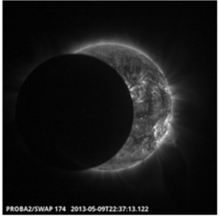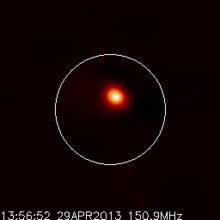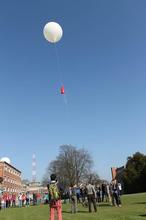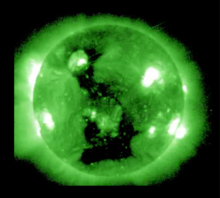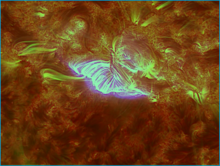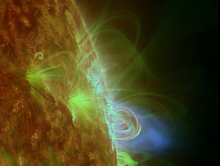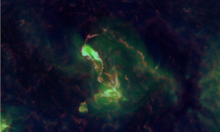news
Submitted on 2013-05-13
SWAP, an EUV images onboard of PROBA2 captured 3 moon walks on May 9 and 10: 2 lunar passages in front of the solar disk and 1 'rolling coin' passage.
The simulation shows 2 extra, however less spectacular lunar passages: the moon passes the Sun from 'far'. These data were not sent to the ground station. Solar eclipses are used to calibrate SWAP and analyse the effect of instrumental stray light.
Submitted on 2013-05-07
On 29 April, members of the BRAMS network observed radio disturbances at 49.97 MHz. BRAMS is short for Belgian RAdio Meteor Stations, and consists mostly of Belgian radio amateurs listening for meteor reflections from a beacon signal sent out by the Geophysical Centre of Dourbes. The main purpose is to study features of the meteors and their source-particles.

Submitted on 2013-05-06
On April 25, the Space Pole was flooded with kids and teenagers. That day, their self-made experiment was hooked on a weather balloon and took off to the border of space.
All-round and Hands-on
|
Submitted on 2013-05-02
During the last fortnight, two coronal holes (one on each solar hemisphere) transited the solar disk, as shown in this clip from GOES15/SXI imagery. Passing the disk's centre around 22-23 April, the high speed gusts of energetic particles created active geomagnetic conditions on 25 April and even a brief minor storm period on 26 April.

Submitted on 2013-04-26
It's always impressive to see sunspots develop from scratch, and cluster into an ominously looking sunspot group. Early on Friday 19 April, magnetic fields pushed through the solar surface and did just that in less than 24 hours. NOAA 1726 was born, and it was a quite large group: In the image underneath, there is room to easily fit 10 Earths between the outer edges of the two main spots!

Submitted on 2013-04-18
No doubt about it: The M6 flare in sunspot group NOAA 1719 was the highlight of last week's space weather activity.
A movie was created showing the various aspects of this flare and its impact on Earth. Some additional details can be found underneath.
Submitted on 2013-04-11
Sunspots are magnetic disturbances on the surface of the Sun. This was discovered back in 1908 by George Ellery Hale. In the next few decades, technology improved and during the 1950's and 60's, Horace Welcome Babcock and Robert Benjamin Leighton developed the magnetograph (see note 1) to display the magnetic field of the entire Sun. These maps are known as magnetograms. They show essentially white and black patches, mostly corresponding to active regions and sunspot groups (See 4 April 2013 SDO image underneath).
Submitted on 2013-04-04
A solar flare is a sudden release of an enormous amount of energy due to magnetic reconnection in the solar atmosphere, usually above sunspot regions. This energy release takes place over the entire electromagnetic spectrum. Solar flares are often classified according to their peak strength in x-rays. Scientists usually use three categories: "C" (common), "M" (medium) and "X" (extreme), with each category 10 times stronger than the previous one. As an example: an X6-flare is 10 times stronger than an M6-flare, and 600 times stronger than a C1-flare. |
|
Submitted on 2013-03-29
One of last week's highlights certainly was the M1.6-flare in NOAA 1692 near the northwest limb of the Sun. Starting late on 21 March at 21:42UT, it reached its peak flux at 22:04UT and ended at 22:36UT. The event was not accompanied by an energetic proton enhancement. |
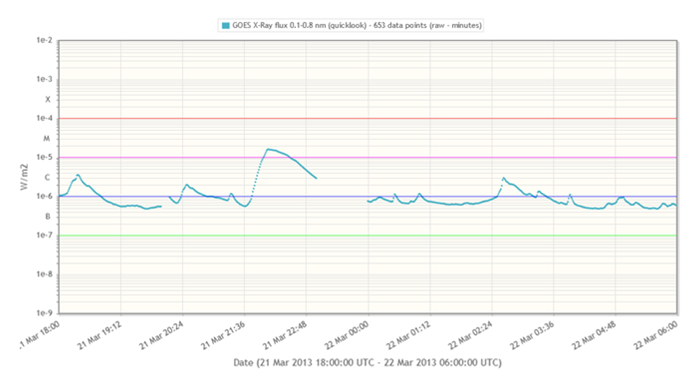 |
|
Submitted on 2013-03-22
The Sun took a good aim at Earth this week.
Pages
Zircon - This is a contributing Drupal Theme
Design by
WeebPal.

